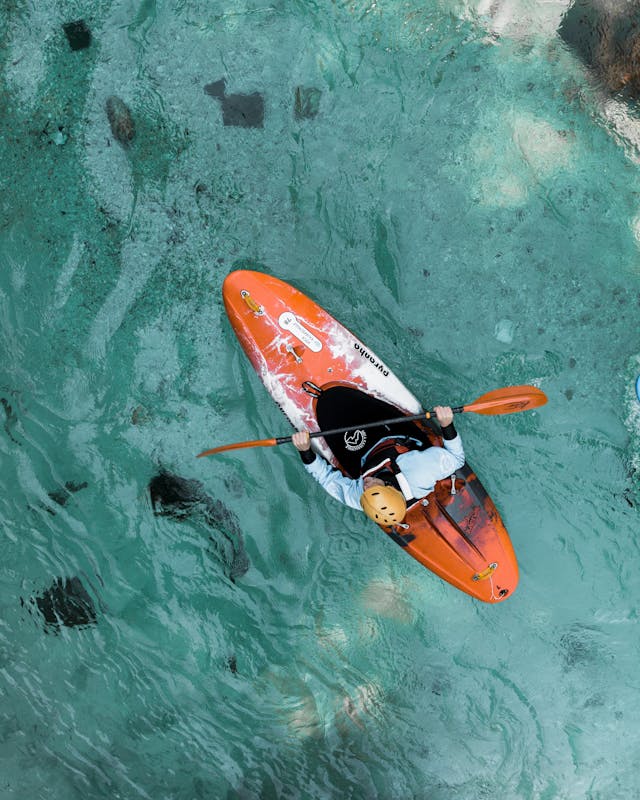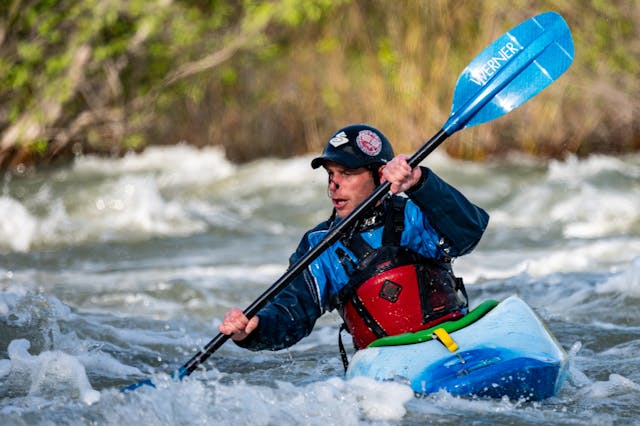Kayak bow rescue is an essential skill that every kayaker should master. It allows a capsized kayaker to get right-side up without leaving the boat. This is crucial because it saves time and keeps water out of the kayak, making the entire process safer and more efficient.

Imagine you’re paddling along a peaceful river when suddenly, you capsize. Instead of struggling to get out and empty your kayak, you can use this technique to regain control quickly. You just grab the bow of an approaching kayak for support, and you’re back upright in no time.
Whether you’re a beginner or an experienced paddler, practicing the kayak bow rescue regularly will enhance your confidence and safety on the water. It’s a skill that pays off, especially in tricky situations.
Key Takeaways
- Kayak bow rescue keeps you in your kayak, saving time and effort.
- Practicing this technique increases confidence and safety.
- This method is essential for both beginners and experienced paddlers.
Fundamentals of Kayak Bow Rescue
Kayak bow rescue is a key technique for recovering a capsized paddler in the water. By understanding the basics, we can ensure safety and efficiency during this process.
Recognizing the Need for Rescue
When a paddler is upside down in their kayak, it’s clear they need help. Often, capsized kayakers will tap on their kayak to signal distress. It’s vital to look for these visual and auditory cues.
We should stay alert to changes in water conditions that might make a capsize more likely. Strong currents or sudden waves can catch a paddler off guard. Recognizing the need quickly allows us to respond effectively and prevent further issues.
Roles and Responsibilities
In a kayak bow rescue, both the capsized paddler and the rescuer have specific roles. The capsized paddler should remain calm and in contact with their kayak. They should reach out to grab the rescuer’s bow as it approaches.
The rescuer needs to maneuver their kayak close to the capsized one. Positioning the bow near the paddler’s hands allows them to grip it and use it to right themselves. Clear signals and communication between the paddler and rescuer are crucial to success.
Safety Precautions
Safety is paramount in any rescue operation. Both the capsized paddler and the rescuer should wear life jackets. Keeping calm helps prevent panic that could worsen the situation.
We need to be mindful of the water conditions, checking for hazards like rocks or strong currents. It’s important to ensure that both kayaks are stable and that the rescue doesn’t put either paddler at more risk. Practicing this technique in controlled environments builds confidence and skill, ensuring readiness in real situations.
Executing the Kayak Bow Rescue Technique

The kayak bow rescue, also known as the T-rescue, involves using another kayak’s bow to help an overturned paddler right themselves without exiting the cockpit. We focus on approaching the capsized kayak, performing the T-rescue, assisting re-entry, and ensuring stability.
Approaching the Capsized Kayak
First, we should kayak toward the overturned boat slowly. It’s important to check for any signs of distress from the capsized kayaker. Approach at an angle to have better control and visibility. Coming in too fast could add instability, making it harder to help.
When close enough, our goal is to position our kayak parallel or perpendicular to the overturned kayak. These angles provide the best leverage for the rescue. The key is to keep our paddle ready for quick adjustments to maintain balance and control.
Performing the T-Rescue
To perform the T-rescue, we gently place the bow of our kayak within reach of the capsized paddler’s hands. The capsized kayaker should feel for our bow and grab it securely. Communication here is vital to ensure proper understanding of the next steps.
We need to keep our kayak as steady as possible during this process. Maintaining a firm grip on our paddle while providing a stable platform is crucial. The capsized kayaker will push down on our bow to help flip their kayak upright.
Assisting with Re-entry
Once the kayak is upright, the next step is to assist the paddler back into their cockpit. This requires coordination and a bit of strength. The kayaker can use a heel hook or other re-entry method to climb back.
We should ensure our boat remains stable to prevent further capsizing. Positioning ourselves at the right angle helps in offering the most support. Our hands should be ready to help if needed, guiding the kayaker’s foot or body into the right position.
Stabilizing and Communicating
After re-entry, stability is the priority. Holding onto the kayaker’s boat temporarily provides extra support as they settle back into the cockpit. We should monitor their condition, ensuring they don’t feel too shaken or unstable.
Communication throughout this entire rescue operation is essential. Clear, calm instructions help the capsized paddler know what to expect. Reassuring words can make a big difference to someone who’s just been through a potentially frightening capsize.
Performing a kayak bow rescue effectively requires practice and coordination between both paddlers. By staying calm and focused, we can execute the technique smoothly and safely.
Practical Skills and Drills
Focusing on practical skills and drills can significantly improve your kayak rescue techniques. Here, we break down critical practices such as solo and partner maneuvers, essential hip snap and bracing drills, and handling various capsize scenarios.
Solo and Partner Practices
Practicing kayak rescues alone or with a partner helps build confidence and ensures safety on the water. Solo practice typically involves self-rescue techniques like the paddle float rescue. With a paddle float, you can stabilize your kayak, allowing you to re-enter after a capsize.
Partner practices might include the T-rescue, where one kayaker helps another by positioning their kayak at a T-angle. This method allows the capsized paddler to right their kayak efficiently. Communication is key here to ensure the assisting paddler knows when to lift and stabilize.
Hip Snap and Bracing Drills
Hip snap and bracing drills are fundamental to rolling your kayak and maintaining balance. The hip snap involves a quick, powerful movement of the hips to right an overturned kayak. This motion can be practiced in controlled environments with ample supervision.
Bracing drills focus on maintaining balance using paddle support. There are high braces and low braces, each used in different scenarios. Practicing both ensures you can handle sudden tilts and maintain an upright position. Each drill should be performed repetitively to build muscle memory and ensure quick, natural responses during a capsize.
Capsize Scenarios
Capsize drills prepare you for unexpected turnovers. One common practice is the wet exit, where you exit the kayak safely underwater. This drill is essential for all paddlers to learn how to release the spray skirt and float to the surface quickly.
Another critical scenario involves performing self-rescue and assisted rescues. For instance, the Eskimo Bow Recovery involves using a partner’s kayak bow to re-enter your kayak. These drills help you respond effectively during actual emergencies and build trust between paddling partners. By regularly practicing these skills, you become more adept at handling real-life capsize situations, ensuring safety and confidence on the water.
Advanced Considerations
In kayaking, mastering the bow rescue technique is essential, but advanced conditions can complicate matters. Key aspects include handling currents, managing cold water, and adapting methods for sea kayaking.
Dealing with Currents and Strong Winds
Currents and strong winds can make a rescue more challenging. When facing strong currents, position the assisting kayak upstream. This allows the current to help you stay aligned. In windy conditions, approach the overturned kayak from a downwind direction to maintain control.
Using an Eskimo Bow Recovery where the assisting paddler places their bow into the hands of the capsized paddler can be effective. Keep communication open and brief to coordinate movements swiftly.
Cold Water Rescue Challenges
Cold water presents unique dangers, including hypothermia. Always wear a wetsuit or drysuit. Quick action is vital. Once the capsized paddler is righted, help them get their spray skirt back on to minimize water intake.
For cold water rescues, maintaining contact with the rescue kayak is crucial. This helps prevent further immersion and heat loss. Speed up the rescue process, as cold conditions can quickly sap strength and dexterity.
Adapting Techniques for Sea Kayaking
Sea kayaking often involves larger swells and more complex conditions. The X Rescue technique can be beneficial. This involves approaching the upturned kayak and grasping it at the bow, ensuring the capsized paddler stays in contact with either their own or the rescue kayak.
When adapting the bow rescue for sea conditions, it’s vital to be aware of the changing environment. Whitewater kayaks might need different approaches due to their design. Continuous observation of the water’s behavior will help in adjusting the technique to ensure safety.
By focusing on these advanced considerations, we can effectively manage more challenging rescues and ensure a safer kayaking experience.
Frequently Asked Questions
When performing rescues and safety techniques while kayaking, it’s crucial to know the essential steps and methods involved. Understanding different types of rescues can make a big difference in staying safe on the water.
Q: What are the essential steps for performing a T-rescue with a kayak?
A: The T-rescue involves two kayakers. One paddler flips the kayak upright while the other assists.
First, position the bow of the assisting kayak perpendicular to the capsized one. The rescuer holds onto the capsized kayak’s bow, making a T-shape. Using the leverage, the capsized paddler can pull and flip the kayak back to its upright position. For more information, visit PaddlingSpace.com.
Q: How does one properly execute a wet exit from a capsized kayak?
A: A wet exit is essential when you flip over. When your kayak capsizes, stay calm and lean forward. Pull the spray skirt loop, push the back of your seat, and slide out of the cockpit.
Practice makes this process smoother and ensures you’re safe even in turbulent water. You can watch additional techniques on Paddling.com.
Q: Can you explain the different types of kayak rolls and their purposes?
A: There are several types of kayak rolls, each with different purposes. The Eskimo roll is popular and involves using your paddle and hips to right the kayak.
The C-to-C roll and Sweep roll are variations that can be used depending on the situation. Mastering these rolls increases safety and efficiency in challenging conditions.
Q: What is an Eskimo rescue and how does it differ from other kayak rescues?
A: An Eskimo rescue involves a paddler assisting another who is upside down. The assisting paddler places their bow into the hands of the capsized paddler, who then uses it to roll the kayak upright. This differs from the T-rescue, where the rescuing paddler physically flips the kayak. Detailed steps can be found at Paddling.com.
Q: What are the safety protocols to follow during a kayak bow rescue?
A: Safety is paramount during a bow rescue. Always communicate clearly with your partner. Make sure your equipment is secure and in good condition.
Maintain balance and use the appropriate grip to avoid injury. Practice in calm waters before attempting in rough conditions for added safety.
Q: What should paddlers know about self-rescue techniques in kayaking?
A: Self-rescue techniques include methods like the paddle float rescue. Attach a float to one end of the paddle, making an outrigger. Use this for balance while you re-enter the kayak from the water.
Knowing these techniques ensures you can handle situations by yourself when necessary. More tips on self-rescue can be found on BoardandKayak.com.

